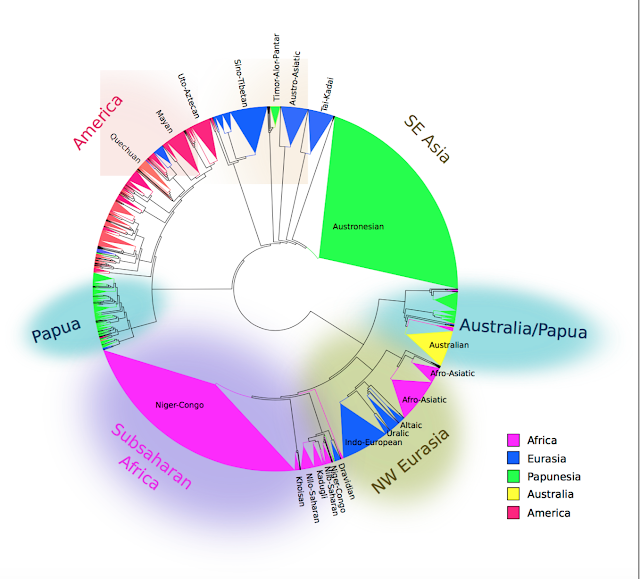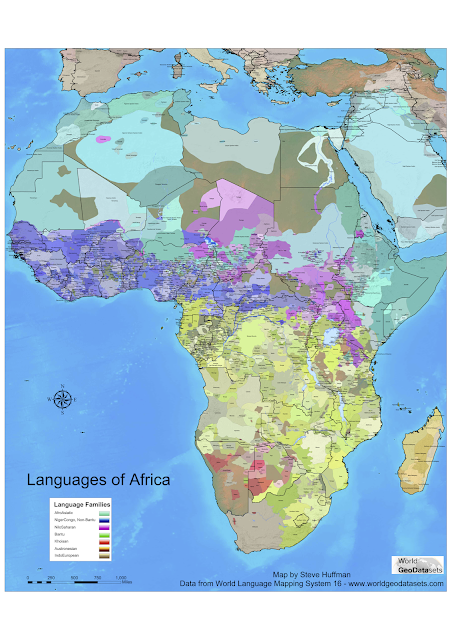The Closing Conference of the MPIEVA Linguistics Department - Diversity Linguistics: Retrospects and Prospects
This week was the closing
conference of the linguistics department of the Max Planck Institute for
Evolutionary Anthropology in Leipzig - Diversity Linguistics: Retrospects and Prospects. (Written about before with much excitement by Hedvig here and here.)
The talks were wonderful, presenting results of work done over many years. This
is a partial and idiosyncratic summary of my experience there, which has to leave out talks that I couldn't get to due to schedule clashes in the program. They are listed here roughly by chronology, or by theme. You can see the list of all talks and access their abstracts here. A set of photos of the conference is here.
Bernard
Comrie summarized the achievements of the department over the past seventeen
years, probably the main one being the World Atlas of Language Structures first
proposed and built by Martin Haspelmath and David Gil. This database set the precedent for
linguistic databases that followed, including the ones that Russell Gray has
now announced building at the new institute in Jena.
Work
on language and genetics was summarized by Brigitte Pakendorf on male and
female gene flow in Burkina Faso, Khoisan populations and northeastern Siberia. One key result was that Y chromosome DNA was
often not shared between unrelated populations, wheareas mitochondrial DNA
would be. This suggests language contact
in these cases has been due to female migration between groups. The results support a wider generalization,
that language families have often been brought by men (invading armies or
farmers), and hence Y chromosome DNA often is more sharply distinguished
between language families (Forster and Renfrew 2011). One unusual result was from language contact in
Siberia, where male migration had happened between unrelated populations, and a
verbal paradigm had been borrowed across languages. I wondered whether this could be a signal of
relatedness between those languages rather than contact (it is sometimes
possible for just morphology to survive in cases of language shift, rather than
any vocabulary).
Paul Sidwell presented his family tree of Austro-Asiatic using many years of vocabulary data collection (all freely available to people who email him) and phylogenetic analysis, supported by Russell Gray and Simon Greenhill.
Søren Wichmann used ASJP data to show language families and track likely migration routes, including comparing rates of migration through different ecological environments.
Søren later composing at the piano
Michael
Cysouw presented his database of over 1700 Bible translations, and the innovative
comparative work which can be done using them, such as how apparently simple
words such as ‘husband’ or ‘wood’ can vary across Germanic languages in the way
that they are used. The Bible translations are a rich resource, but much of the work needed to exploit them still needs to be done, such as developing algorithms for finding word forms in morphologically complex languages.
Amina Mettouchi presented her corpus of annotated one-hour conversations in thirteen Afro-Asiatic languages, a more sophisticated means of language comparison that is also being pushed by the MPI in Nijmegen.
Patience Epps presented her data on vocabulary in South America, showing striking patterns of how populations have interacted. Terms for drugs and alcohol had travelled the furthest, and then terms for bird species, which are often onomatopoeic.
Bernd Kortmann talked on the World Atlas of Varieties of English, showing grammatical differences and the influence of other languages.
Balthasar Bickel used grammatical properties from the AUTOTYP database to show large areas of the world that have historical connections. The main innovation was the new control for language relatedness using phylogenetic methods (although a simplified version which does not take the family structure into account); and the main result was a striking map which showed the whole of Eurasia as a different colour from Africa and the Pacific, potentially showing deep-time connections between families across the entire continent. I think some of this appearance of homogeneity might be an artifact of the way that he assigned colours to entire families (e.g. the whole of Indo-European received one colour, if I followed correctly), but the approach is interesting.
Harald Hammarström presented his exhaustive analysis of basic word order: literally every language in the world has now been checked for its basic word order (around 5200 data points, 82 languages with no access to information, and the remaining known to have no data on word order). He also quantified the roles of inheritance, universal tendencies and language contact, with intriguing results although perhaps underestimating the role that language contact played, as well as language relatedness beyond known language families.
A
more purely linguistic question was the problematic notion of ‘affix’, discussed
first by Matthew Dryer using a new survey of a few hundred grammars, and by
Susanne Maria Michaelis who showed the inconsistency of this term when
describing creole languages in the APiCS database.
A couple of talks I went to had brilliant hypotheses even if the approach was flawed. David Gil presented the craziest set of experiments that I’ve ever seen, with some photos of him carrying them out on his laptop with people from the street in Naples to hunter gatherer communities in Papua New Guinea and South Africa. His claim was that some languages allow flexibility in the interpretation of sentences, such as allowing the (in English) nonsensical sentence
‘The clown is drinking the book’
to be interpreted as meaning
‘The clown is drinking while reading the book’.
In English this interpretation is not possible, but he claimed that many languages do allow this flexibility of interpretation – in his terms, less strict compositional semantics. He would show a participant two pictures (a clown drinking while reading a book, and an unrelated picture), and ask the participant to choose which picture matched the sentence, or whether neither or both of them did. An English speaker would choose the option ‘neither’. Speakers of other languages would often choose the picture of the clown drinking while reading a book. Gil tested speakers of Khoe languages, Italian dialects, Japanese, Cantonese, and various languages in Indonesia.
The results were striking and intriguing (in Paul Heggarty’s words) – languages tended to be more flexible in interpretation when they were a non-national languages, such as Khoe languages; or a little less flexible if they were a non-standard variety of the national language (such as Neapolitan Italian); and even less flexible if they were a national language, such as Italian. Gil proposed that languages have been culturally evolving to be more strict in their rules for compositionality, and that this is how languages evolved at an even greater time-depth from the first human proto-languages. Paul Heggarty pointed out in the questions that the results might mean that languages vary in how prescriptive they are, rather that how semantically flexible they are.
Others pointed out that the experiments were badly designed in that they did not reflect actual usage by speakers. As he said in response, his hypothesis is in fact testable using conversational corpora, such as the collection of conversations in Nijmegen of languages from Papua New Guinea, South Africa, Mexico and South America; if he is right, the smaller the language community, the more likely there is to be flexibility in the interpretation of sentence meaning.
to be interpreted as meaning
‘The clown is drinking while reading the book’.
In English this interpretation is not possible, but he claimed that many languages do allow this flexibility of interpretation – in his terms, less strict compositional semantics. He would show a participant two pictures (a clown drinking while reading a book, and an unrelated picture), and ask the participant to choose which picture matched the sentence, or whether neither or both of them did. An English speaker would choose the option ‘neither’. Speakers of other languages would often choose the picture of the clown drinking while reading a book. Gil tested speakers of Khoe languages, Italian dialects, Japanese, Cantonese, and various languages in Indonesia.
The results were striking and intriguing (in Paul Heggarty’s words) – languages tended to be more flexible in interpretation when they were a non-national languages, such as Khoe languages; or a little less flexible if they were a non-standard variety of the national language (such as Neapolitan Italian); and even less flexible if they were a national language, such as Italian. Gil proposed that languages have been culturally evolving to be more strict in their rules for compositionality, and that this is how languages evolved at an even greater time-depth from the first human proto-languages. Paul Heggarty pointed out in the questions that the results might mean that languages vary in how prescriptive they are, rather that how semantically flexible they are.
Others pointed out that the experiments were badly designed in that they did not reflect actual usage by speakers. As he said in response, his hypothesis is in fact testable using conversational corpora, such as the collection of conversations in Nijmegen of languages from Papua New Guinea, South Africa, Mexico and South America; if he is right, the smaller the language community, the more likely there is to be flexibility in the interpretation of sentence meaning.
A similarly intriguing but controversial talk was by Johanna Nichols presenting work arguing for ancient migrations of a population in eastern Eurasia (the ‘Pacific Rim') westwards, influencing every other language family in Eurasia. She presented striking correlations between various typological properties and longitude - the further east you go in Eurasia, the more likely that you have a particular structure. However, these correlations may arise in some cases from non-independence of related languages: you can get a correlation between Indo-European properties and longitude, for example, if you are not controlling for language relatedness (or perhaps even if you are, given that Indo-European properties can travel by local instances of language contact such as with Basque, Dravidian and Finno-Ugric). As with David Gil’s talk, I see her ideas as ideas to work on and test more rigorously, although intriguing in the hypothesis put forward.
Russell Gray gave the closing talk, ‘Think Big! The Bright Future of Linguistics.’ In it he described methods of dating the spread of Indo-European, after the renewed discussion in two papers published in Nature and Language in January, and new possible explanations for patterns of language diversity in Australia. He announced plans at his new institute in Jena to build large databases of vocabulary and language structures (the plan is to code 3000 languages for 200 structural properties), under the general name ‘GlottoBank’. He challenged the audience to think of the ‘Hilbert problems’ of linguistics (after the mathematician David Hilbert, and the non-related linguist Martin Hilpert who presented at the SLE on this topic, covered by Hedvig here); and covered other exciting projects such as fieldwork in Vanuatu and incipient work on the question of why some places in the world are more linguistically diverse than others. He also announced the completion of two new databases, one on Pacific religions, and one on cultural traits in 1300 populations worldwide, which will be online later this month.
Three days ago there happened to be an opinion piece in the New York Times that gives a depressing picture of what academic conferences in the humanities are often like. This conference was the exact opposite of everything that it lists. Rooms were routinely packed, with people standing outside the door or sitting on steps, every seat filled. Talks were clear and well presented (talks by Brigitte Pakendorf, Östen Dahl and David Gil were entertaining in particular). Many people said that the atmosphere was like a reunion or a family gathering, and the discussions outside of talks were stimulating as well. This may partly be because of the unusual context of the conference, but it is also because comparative linguistics has grown into an exciting field, with much of the current trend towards collaboration and building large databases inspired by the Linguistics department in Leipzig. Farewell and thank you to them!






Comments
Post a Comment